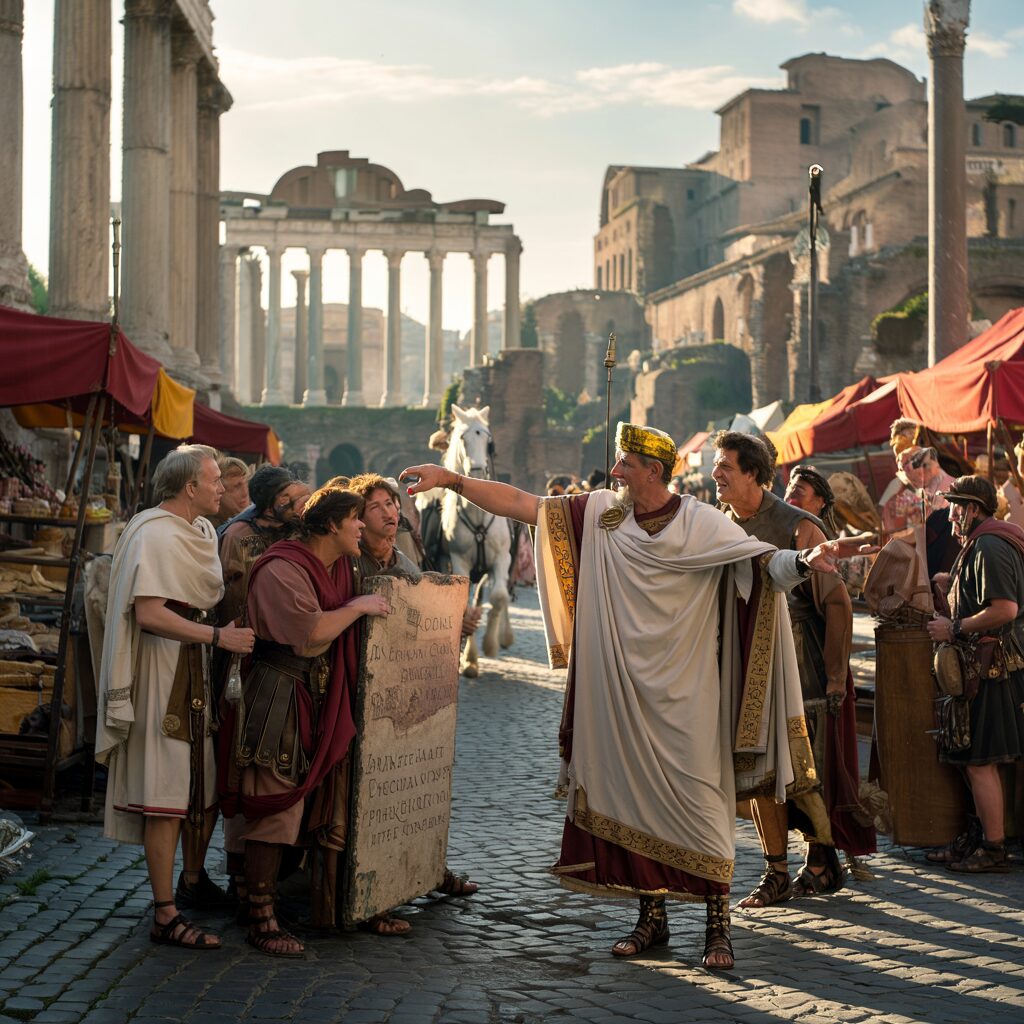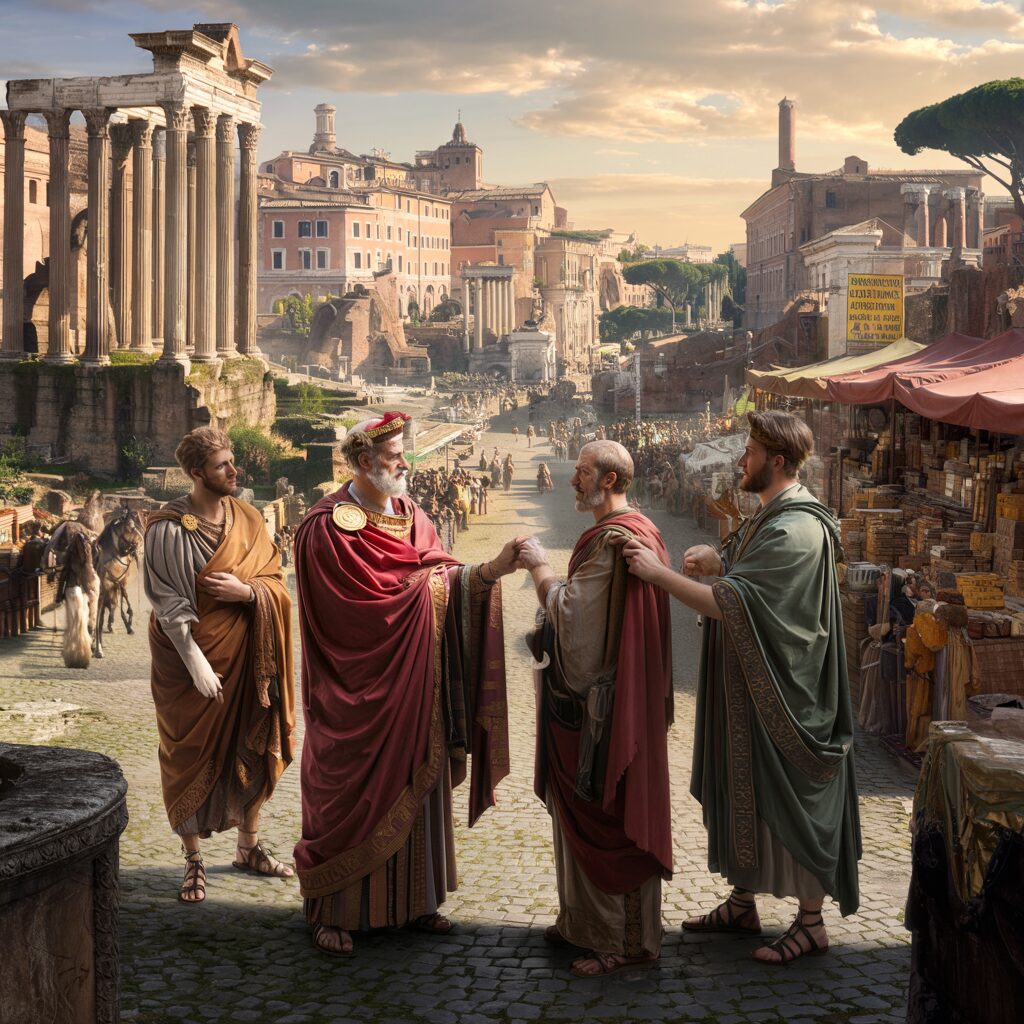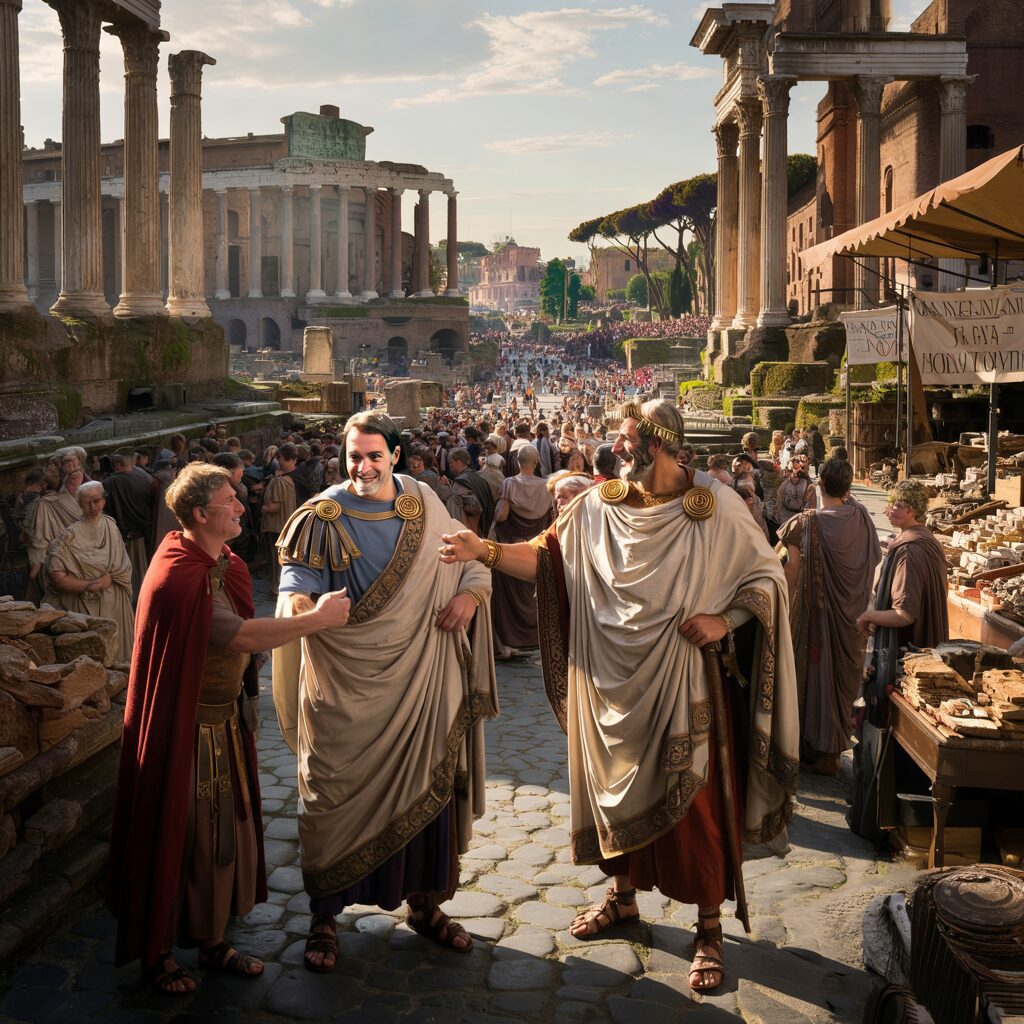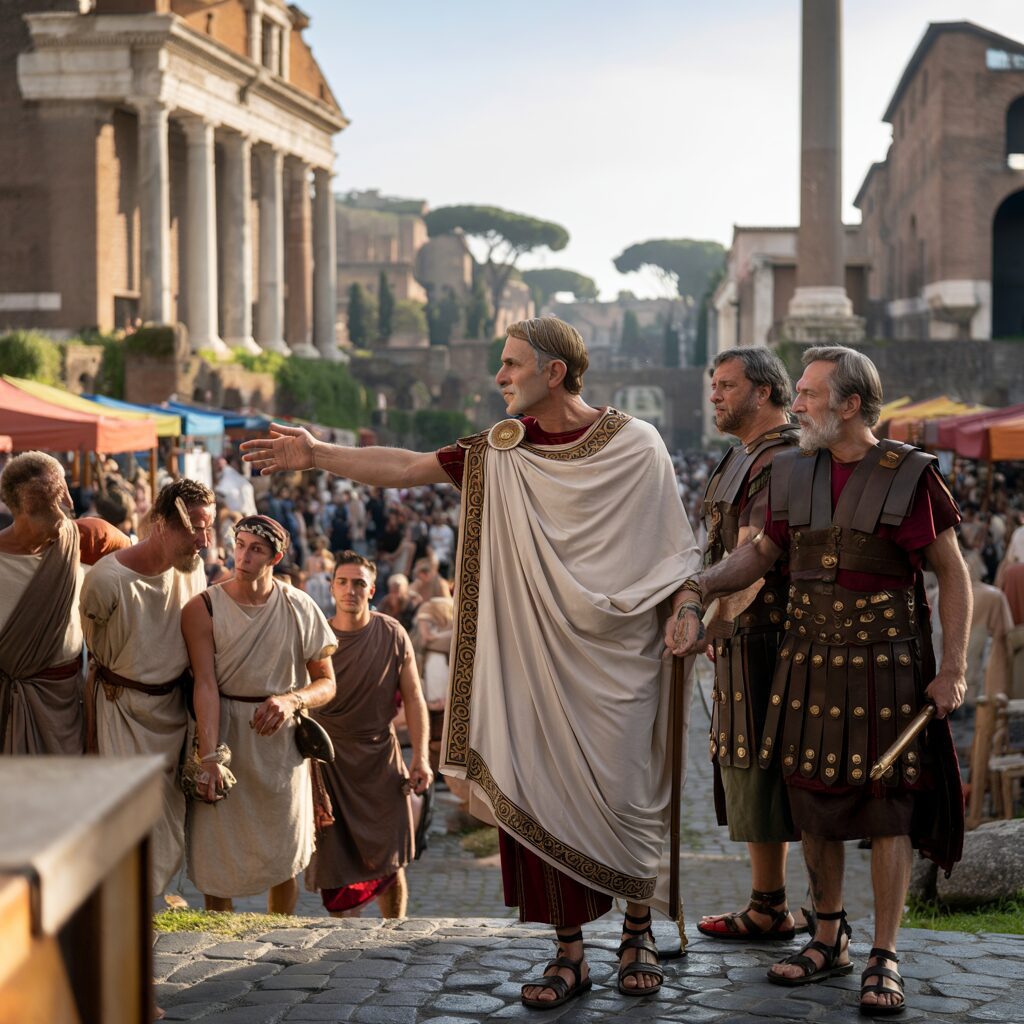Roman society had a strict hierarchical structure known today as the Roman social ladder. Social status was not just a matter of personal pride—it determined one’s rights, privileges, and opportunities. This ladder was shaped by multiple factors:
- Heredity and family background
- Wealth and property ownership
- Citizenship and legal standing
Social mobility in Rome was limited but possible. Movement up or down the social ladder depended heavily on connections and influence rather than merit alone. The key mechanism enabling such shifts was the system of patronage networks—complex relationships linking patrons (powerful individuals) with clients (those seeking protection or advancement).
Patronage networks functioned as the social glue binding Roman communities. They created channels through which individuals could gain financial support, legal help, political favor, or protection. Climbing the social ladder often meant securing a powerful patron; falling could result from losing these critical ties.
This article explores how Romans navigated these patronage networks to climb—or fall through—the social hierarchy. Understanding these relationships reveals much about social mobility in Rome, highlighting the intricate balance between power, loyalty, and opportunity.
The Structure of Roman Society
Roman society had a strict social structure that determined people’s roles and opportunities. This hierarchy was based on factors such as family background, wealth, citizenship, and legal status. While one’s position in society was often determined by birth, there were some circumstances where individuals could move up the ladder, although it was never easy or guaranteed.
Key factors influencing one’s place in society included:
- Heredity: Noble lineage provided a clear advantage in accessing elite circles such as the Senate.
- Wealth: Ownership of property and financial resources created pathways for social elevation, especially into equestrian ranks.
- Citizenship: Full Roman citizenship granted legal protections and political rights unavailable to non-citizens or slaves.
- Legal Status: Categories like freeborn citizens, freedmen (former slaves), slaves, and non-citizens each had distinct rights and limitations shaping their social mobility.
Understanding the Roman Social Classes
The Roman social order featured several clearly defined classes with specific roles and expectations:
- Senators: The pinnacle of Roman elite society, senators were members of families with considerable wealth and political influence. Entry required holding substantial property (typically 1 million sesterces) and election to public office. Senators enjoyed prestige, control over legislation, and access to imperial favor.
- Equestrians (Equites): A wealthy class just below senators distinguished by a property qualification (usually around 400,000 sesterces). Equestrians often served as businessmen, administrators, or military officers. Though less politically powerful than senators, they formed an influential economic elite.
- Plebeians: Freeborn common citizens who made up the bulk of Rome’s population. Plebeians ranged from prosperous merchants to poor laborers. Some could accumulate wealth sufficient to enter equestrian ranks or hold local office.
- Freedmen: Former slaves who had been granted freedom. Though legally free citizens, freedmen faced social stigma and restrictions preventing full integration into higher classes. Their children could improve status over generations.
- Slaves: Considered property without legal personhood. Slavery was widespread across Roman society; slaves could not own property or marry legally but sometimes gained manumission through patronage or self-purchase.
- Non-Citizens: Residents without Roman citizenship suffered limited legal rights and could not participate fully in political life. Citizenship expanded gradually over time but remained a crucial marker of inclusion.
This complex layering emphasized distinctions in rights, responsibilities, and prestige while allowing limited channels for crossing boundaries through wealth accumulation or patronage networks.

Patronage Networks: The Social Glue of Rome
The patronage system was the foundation of social interactions in Roman society. It revolved around the relationship between patrons (patroni) and clients (cliens), who were connected by mutual obligations and expectations. This system went beyond simple transactions; it was deeply woven into every aspect of Roman life, influencing politics, economics, and social dynamics.
Understanding the Patron-Client Relationship
Patronage involved a powerful individual—the patron—offering various forms of support to one or more clients. These clients depended on their patrons for resources and protection. In return, clients provided loyalty, services, and public acknowledgment of their patron’s status. This reciprocal arrangement created networks that extended influence far beyond individual households.
Who’s Who: The Roles in Patronage
Patrons typically belonged to Rome’s elite classes—senators, equestrians, or wealthy landowners. Their responsibilities included:
- Providing financial assistance or loans
- Offering legal representation or advocacy in courts
- Extending protection from enemies or rivals
- Supporting clients’ political ambitions through votes or endorsements
Clients, often plebeians, freedmen, or lower-status citizens, had duties such as:
- Attending their patron’s public events
- Offering political support during elections
- Performing services ranging from menial tasks to advisory roles
- Publicly praising and acknowledging the patron’s importance
How Patron-Client Relationships Work
This relationship was dynamic and ongoing rather than static. Patrons gained prestige by demonstrating their ability to support numerous clients. Clients reinforced their social standing by affiliating with influential patrons. The network operated like a social safety net and ladder simultaneously.
Mutual support took many forms:
- Protection: Patrons shielded clients from legal troubles or physical harm.
- Financial aid: Loans or gifts helped clients sustain businesses or families.
- Legal help: Patrons used their influence to sway courts or negotiations.
- Political backing: Clients mobilized votes or public opinion to advance patrons’ careers.
These reciprocal relationships were essential mechanisms for navigating The Social Ladder: How Romans Climbed (or Fell) Through Patronage Networks. A client’s success often depended on maintaining good terms with patrons while patrons needed visible loyalty for their reputation.
This intricate web of personal connections made patronage the social glue binding disparate classes together in Rome’s complex hierarchical society.

Mechanisms for Climbing the Social Ladder in Rome
Wealth and property ownership played a crucial role in social mobility in Rome. Accumulating wealth was more than just a measure of economic success; it was a primary vehicle for entering and sustaining positions within the elite. The Roman social ladder often hinged on visible displays of wealth, which signaled an individual’s capacity to fulfill societal roles expected of higher status.
Elite Groups and Property Qualifications
Two main elite groups defined the upper echelons of Roman society: the Senate and the equestrian order. Entry into these circles was not just about birthright but also about meeting strict property qualifications:
- Senators were required to possess property valued at least 1 million sesterces. This high threshold ensured that senators had significant financial resources to support public duties, including funding games, public works, or military campaigns.
- Equestrians, while below senators in rank, needed to demonstrate property worth at least 400,000 sesterces. This class often comprised wealthy businessmen, financiers, and administrators who could leverage their economic power into social prestige.
Ownership of land was particularly important. Landed wealth provided stability and respectability, distinguishing members of these groups from those who accumulated wealth through commerce alone—a pursuit often viewed with suspicion among Rome’s upper classes.
Elections and official offices presented another route for climbing the social ladder. Holding magistracies such as quaestor, praetor, or consul conferred not only political power but also elevated social standing. These offices often required prior financial investment and patronage networks to secure votes and support:
- Serving in elected positions demonstrated loyalty to Rome and public service.
- Officeholders gained access to influential circles where alliances could be forged.
- Political visibility reinforced one’s reputation and opened doors for further advancement.
Participation in elections was competitive and expensive; candidates had to fund campaigns and public events. This system favored those already possessing substantial resources but still allowed ambitious individuals with sufficient backing to rise.
The Social Ladder: How Romans Climbed (or Fell) Through Patronage Networks depended heavily on combining wealth accumulation with strategic use of these political mechanisms. Property unlocked eligibility for elite ranks, while patronage ensured the necessary support to navigate elections and appointments effectively.

Legal Status: A Double-Edged Sword for Social Mobility
Roman citizenship created sharp legal distinctions that deeply affected social mobility. Rights and privileges varied widely among free citizens, slaves, freedmen, and non-citizens. These legal differences often determined the extent to which an individual could climb or fall on the social ladder.
The Impact of Legal Status on Social Mobility
Free Citizens, slaves, freedmen, and non-citizens experienced different levels of rights and privileges under Roman law, which directly influenced their ability to move up or down the social hierarchy.
1. Free Citizens
Free Citizens enjoyed the full spectrum of civil rights, including property ownership, marriage rights under ius civile, ability to make legal contracts, and access to Roman courts. Political participation was also reserved for them, with eligibility for holding public office a key advantage.
2. Slaves
Slaves lacked any personal legal standing. Considered property, they had no rights and were completely subject to their owners’ control. Their social mobility was nearly impossible unless freed.
3. Freedmen
Freedmen occupied a liminal space. Although legally free, they faced social stigma as former slaves and had limited political rights. Freedmen could own property and engage in business but were barred from certain magistracies and priesthoods.
4. Non-Citizens
Non-citizens (peregrini) had even fewer protections under Roman law. They could live within the empire but were excluded from many privileges, including voting and legal recognition in Roman courts.
The Expansion of Citizenship Under Emperor Caracalla
A monumental shift occurred in AD 212 with the Constitutio Antoniniana issued by Emperor Caracalla. This edict extended Roman citizenship to nearly all free inhabitants of the empire.
“By this act, Caracalla dissolved many distinctions between citizens and non-citizens, theoretically expanding access to legal protections and civic participation.”
This expansion:
- Removed previous barriers that limited social advancement based on citizenship.
- Allowed many provincials new opportunities to acquire wealth, hold local offices, and enter patronage networks as clients or patrons themselves.
- Increased tax revenues but also integrated diverse populations more tightly into Roman social structures.
Citizenship’s Influence on Privileges and Advancement
Holding Roman citizenship was a gateway to numerous privileges that facilitated climbing the social ladder:
- Access to legal contracts enabled wealth accumulation through business ventures.
- Eligibility for military officer ranks or administrative posts provided paths into elite circles.
- Participation in elections allowed citizens to support or seek public office.
Citizenship status thus shaped how effectively one could leverage patronage networks or institutional roles for upward mobility. Conversely, lack of citizenship severely constrained these opportunities despite other forms of success.
Understanding legal status as both a protective shield and a potential barrier highlights why Romans fiercely guarded their citizenship rights while aspiring lower classes sought inclusion through various means — including patronage ties — to break through rigid societal walls.

Patronage Networks Within Broader Social Structures in Rome
Roman patronage networks extended beyond individual relationships to permeate key institutions within Roman society, offering unique avenues for social advancement and power dynamics. The integration of patronage within structures like the military, trade guilds, and religious bodies not only solidified social hierarchies but also provided opportunities for individuals to navigate the complex web of Roman society.
1. Military Patronage
In the military, patron-client relationships were instrumental in securing promotions, commands, and other prestigious positions. Generals often acted as patrons to their subordinates, offering not just military advancements but also political support and financial backing. This symbiotic relationship ensured loyalty and support within the ranks while enabling individuals to rise through the military hierarchy based on connections and favoritism rather than solely on merit.
2. Trade Guilds in Rome
Trade guilds were another domain where patronage played a crucial role in shaping social mobility. Within these professional associations, established members (patrons) provided guidance, resources, and access to lucrative opportunities for newcomers or clients. By aligning with influential figures in trade guilds, individuals could secure apprenticeships, business partnerships, and eventual leadership roles that propelled them up the social ladder.
3. Religious Bodies
Patronage networks also thrived within religious institutions, where priests or religious leaders acted as patrons to their followers. These relationships not only offered spiritual guidance but also opened doors to social gatherings, communal activities, and influential connections. Advancement within religious hierarchies often depended on one’s patron-client network, with patrons endorsing their clients for prestigious roles or responsibilities within the religious community.
Advancement Opportunities Within Institutions
Within these institutional frameworks, individuals had the chance to leverage their patron-client relationships for personal gain and societal recognition:
- Access to Offices or Titles: Through their patrons’ influence, individuals could secure appointments to coveted positions within the military command structure, trade guild leadership roles, or prominent roles in religious ceremonies. These titles not only conferred prestige but also granted access to networks of power and privilege that facilitated further advancement on the social ladder.
In essence, patronage networks intertwined with broader social structures in Rome to create a multifaceted system of advancement that rewarded loyalty, connections, and reciprocity. By understanding and engaging with these institutional patronage dynamics as outlined in this detailed analysis, individuals could strategically navigate Roman society’s complex hierarchy and seize opportunities for upward mobility.
Constraints on Upward Mobility in Roman Society
Roman society’s hierarchical structure placed significant constraints on individuals’ ability to climb the social ladder, particularly due to their birth status and the challenges faced by lower classes:
1. Birth Status Limitations
- Despite legal freedoms and potential for social mobility, one’s birth status often served as a barrier to advancement.
- Individuals born into lower classes or with slave ancestry encountered deep-seated prejudices that hindered their upward mobility.
- The elite classes, including senators and equestrians, maintained a tight grip on power and influence, making it difficult for those from lower strata to break through these social barriers.
2. Social Stigma of Ex-Slaves
- Ex-slaves faced considerable social stigma even after gaining their freedom.
- Their past servitude often overshadowed any achievements or merits they acquired later in life.
- This stigma not only affected their personal reputation but also limited their opportunities for advancement in Roman society.
3. Challenges Faced by Lower Classes
- Individuals from the lower classes encountered numerous obstacles in their efforts to improve their social status.
- Limited access to education, resources, and political connections placed them at a disadvantage compared to the privileged elite.
- The rigid social hierarchy made it challenging for individuals from humble backgrounds to break into higher echelons of society, perpetuating existing disparities in wealth and power.
Despite the legal framework that theoretically allowed for social mobility, the realities of Roman society often favored those born into privilege while presenting formidable obstacles to those seeking to ascend the social ladder from lower classes. Birth status, coupled with societal prejudices and structural inequalities, significantly restricted the upward mobility of many individuals in ancient Rome.
Falling Through the Social Ladder: Risks and Consequences
In Roman society, maintaining one’s position on the social ladder required more than wealth and status; it demanded constant upkeep of patron-client relationships. The loss of patronage support often triggered a rapid social decline in Rome. When a patron withdrew protection or failed to provide aid, clients faced increased vulnerability to legal troubles, financial instability, and diminished political influence.
Failure to maintain these ties could lead to:
- Loss of legal defense in courts.
- Exclusion from political networks and voting blocs.
- Decline in economic opportunities through trade or employment.
- Social isolation from elite circles.
Clients depended heavily on their patrons for resources and advocacy. A severed relationship meant losing access to the very mechanisms that enabled upward mobility or even stability within the hierarchy. Patrons themselves might abandon clients due to shifts in their own fortunes or political calculations, leaving clients exposed.
Economic Hardship or Political Shifts Leading To Decline
Economic downturns frequently forced individuals and families down the social ladder. Poor harvests, market crashes, or loss of land could deplete wealth crucial for sustaining status. Even wealthy Romans risked social decline if debts mounted or investments failed.
Political upheavals played a significant role in destabilizing social positions:
- Changes in leadership could result in loss of favor for certain patrons and their clients.
- Reforms altering property qualifications excluded some elites from office.
- Civil wars and purges disrupted established patronage networks.
For example, during periods of imperial transition or senatorial purges, many lost political offices and their associated privileges. Without official roles, their ability to maintain clienteles weakened, accelerating downward mobility.
Economic hardship and political shifts were intertwined with patronage dynamics. A patron suffering financial ruin could no longer support clients effectively; a client caught on the losing side of politics might find all networks closed off.
The Social Ladder: How Romans Climbed (or Fell) Through Patronage Networks depended heavily on reciprocal loyalty and continuous mutual benefit. Once those ties frayed, even previously secure individuals faced the real risk of slipping into lower social strata—sometimes irreversibly. This precarious balance highlights how fragile Roman social standing could be despite outward appearances of rigidity.

